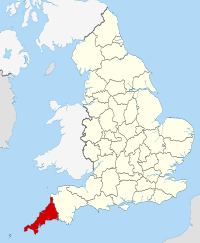"The Greeting".
Artist: Walter Langley (1852–1922).
Date: 1904.
(Wikimedia Commons)
Text is from Wikipedia - the free encyclopaedia.
Walter Langley (8 June 1852 – 21 March 1922) was an English painter and Founder of The Newlyn School of plein air artists.
In 1884, Langley was elected a member of the RBSA and continued to exhibit widely throughout the U.K,, and abroad. Later in his career, his reputation grew. One of Langley's paintings was singled out as "a beautiful and true work of art" by Leo Tolstoy, in his book " What is Art ? ", while, in 1895, Langley was invited by The Uffizi to contribute a self-portrait to hang alongside those of Raphael, Rubens and Rembrandt in their collection of portraits of great artists.
Today his work is considered "vital to the image of The Newlyn School" and, "alongside Stanhope Forbes . . . the most consistent in style and substantial in output".
Cornwall (Cornish: Kernow), is a Ceremonial County and Unitary Authority area of England within The United Kingdom. Cornwall is a peninsula bordered to the North and West by The Celtic Sea, to the South by The English Channel, and to the East by The County of Devon, over The River Tamar.
Cornwall has a population of 536,000 and covers an area of 3,563 km2 (1,376 sq mi). The Administrative Centre, and only City in Cornwall, is Truro, although the Town of Saint Austell has the largest population.
Still retaining their traditional character, the villages of Kingsand and Cawsand, in Cornwall, situated on the Rame Peninsula, are popular with tourists. They are untouched by time with a fascinating smuggling and fishing past.
Illustration: CORNISH TRADITIONAL COTTAGES
Cornish Pilchards.
Delicious.
Illustration: AMAZON
Cornish Pilchard
(Sardina pilchardus).
Photo: April 2011.
Source: Own work.
Attribution: © Citron / CC-BY-SA-3.0.
Author: Citron/ CC-BY-SA-3.0.
(Wikimedia Commons)
"Between The Tides".
Artist: Walter Langley (1852–1922).
Date: 1901.
(Wikimedia Commons)
" The Waif ".
Artist: Walter Langley (1852–1922).
Date: 1889.
(Wikimedia Commons)
The area is noted for its wild moorland landscapes, its long and varied coastline, its attractive villages, its many place-names derived from the Cornish language, and its very mild climate. Extensive stretches of Cornwall's coastline, and Bodmin Moor, are protected as an Area of Outstanding Natural Beauty.

English: Saint Piran's Flag, Flag of Cornwall
Kernowek: Baner Peran, Baner Kernow
Ænglisc: Cornwealla fana
Brezhoneg: Banniel Sant Piran
Cymraeg: Baner Cernyw
Deutsch: Flagge von Cornwall
Français: Drapeau de saint Piran, Drapeau des Cornouailles
Gaeilge: Bratach na Chorn
Latina: Vexillum Cornubiae

The County of Cornwall
shown within England.
Date: 16 November 2010.
Source: Ordnance Survey OpenData:
County boundaries and GB coastline.
Irish, French and Isle of Man coastlines,
Lough Neagh and Irish border.
Author: Nilfanion.
(Wikimedia Commons)
Cornish Pasty.
Illustration: CORNISH PASTY ASSOCIATION
























